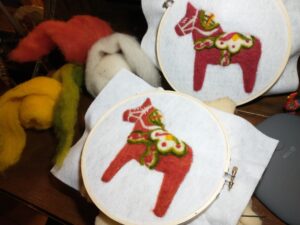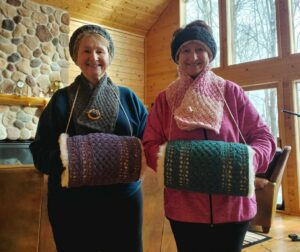 I’m not much for watching TV, as you might have surmised. The few winter evenings we do watch a program, it’s almost always a documentary, preempted by someone calling out, “Let’s learn something!”
I’m not much for watching TV, as you might have surmised. The few winter evenings we do watch a program, it’s almost always a documentary, preempted by someone calling out, “Let’s learn something!”
Learning, in our house, was not something you did only during school hours—it was a part of everyday life that was encouraged and celebrated. Mom read to us aloud voraciously; we visited museums, galleries, and historic sights nearly everywhere we went; the library staff knew us by name; and PBS programs like Nova, Frontline, and American Experience added to the litany of resources we utilized to feed our eager appetites for learning. Mentorships, classes, workshops, conferences, concerts, performances, and internships wove in the elements of person-to-person learning. Even my voice teacher often remarked about our propensity for research and exploration, no matter the topic.
I grew up thinking this was normal. A lifestyle infused with Montessori methodology and un-schooling sensibilities meant that curiosity and creativity flourished and boredom was not even a part of the vocabulary. As the months of physical isolation in the face of the COVID-19 pandemic grind on, I’ve witnessed how this nurtured skillset has been vital to staying sane and fulfilled. It’s also become clear how much need there is to share some of that skillset with others.
There’s a pure energy that is present in the practice of lifelong learning that can carry hours by like minutes. I easily find time slips past when I sit down at one of my looms, experimenting with the interweaving of new colors and textures. “What happens if I…” and pretty soon dawn has turned into day and the chickens are grumbling, wondering when I will arrive with their breakfast! You may have experienced this with a good book or a project of your own.
Learning and making are interwoven. In “Why We Make Things and Why It Matters: The Education of a Craftsman,” author, educator, and furniture maker Peter Korn speaks of his process as “thinking with things.” Through the practice of bringing ideas into form, not only are the physical materials brought through a process of transformation and becoming, but so too is the maker. When we try something, we learn. When we explore something, we learn. When we ask questions and investigate possible answers, we learn. We are wired for learning, if we choose to be engaged, rather than numb ourselves or tune out.
Yes, engagement takes effort. Unfortunately, society and schooling practices train us that this effort is undesirable and often beats the innate spark for engagement out of us in preference for obedient complacency. Fortunately, this process can be unlearned, and we can retool ourselves for creative, curious engagement, if we choose.
Unleashing that for others has been a focal passion for me this winter, as I retool myself for a world in which the crowded, hands-on classroom is on hold. Thank goodness I have a techy dad! Cameras become the students’ eyes, a condenser microphone the students’ ears, and the virtual space of Zoom our new classroom. Homes become studios, and we find ways to connect and share despite the difficulties. For some, it has actually made connecting easier than it was before the pandemic.
 “I’m thinking that I actually like taking classes online better,” Patti Goke offered during this last week’s painting with wool Dala Horse class. “I don’t have to travel, and I’ve taken way more classes than I ever did before COVID.” Nodding heads showed she wasn’t the only one with this experience. Patti is a rosemaling instructor, and she shared how one of her recent students tuned in from Australia to join, at 2:00 am local time. Just yesterday, I presented as one of five American and Canadian storytellers on a Zoom event hosted by Tracy Chipman, which included audience members from Scotland! Certainly, they wouldn’t have flown over the oceans to join us in pre-COVID times.
“I’m thinking that I actually like taking classes online better,” Patti Goke offered during this last week’s painting with wool Dala Horse class. “I don’t have to travel, and I’ve taken way more classes than I ever did before COVID.” Nodding heads showed she wasn’t the only one with this experience. Patti is a rosemaling instructor, and she shared how one of her recent students tuned in from Australia to join, at 2:00 am local time. Just yesterday, I presented as one of five American and Canadian storytellers on a Zoom event hosted by Tracy Chipman, which included audience members from Scotland! Certainly, they wouldn’t have flown over the oceans to join us in pre-COVID times.
It’s not that Zoom is new, either, but I (like so many) had never heard of it before 2020. The need to adapt to changing circumstances, however, is a great motivator for learning and skill-building. I grow exuberant when I see that spark light up in others in the face of a challenge. Recently, a few of my students voiced an interest in trying to have an Oxford-style punch needle rug hooking course on Zoom. When my folk schools weren’t ready to take us up on it, I threw out the word to additional past students, and now a small cohort of us are jumping in to give it a try on our own. Other challenges come from the schools themselves, requesting specific materials that launch me into projects and proposals, including a new collaboration with Patti towards interpreting traditional Norwegian rosemaling into needle felted motifs for Vesterheim Folk Arts School.
If you’re growing weary of staying at home, the best remedy I can recommend is to get curious. See wildlife outside your window and wonder about its story? Jump into some research! How I wish we’d had the resources currently available now on Google when our family started homeschooling! Wish you knew how to (bake bread, knit a sweater, fold origami, bead embroider, carve spoons, trace your genealogy…you name it), find a class online. You don’t have to go anywhere now, and learning, exploring, and engagement are all available to you. Just get curious, apply yourself to that curiosity, and the lifelong learning adventure will begin to unfold.
Your version of chickens might get grumbly now and then, but you just might find something that will make them (and you) happier along the way too. See you down on the farm sometime. [Originally published as a “Down on the Farm” article]

